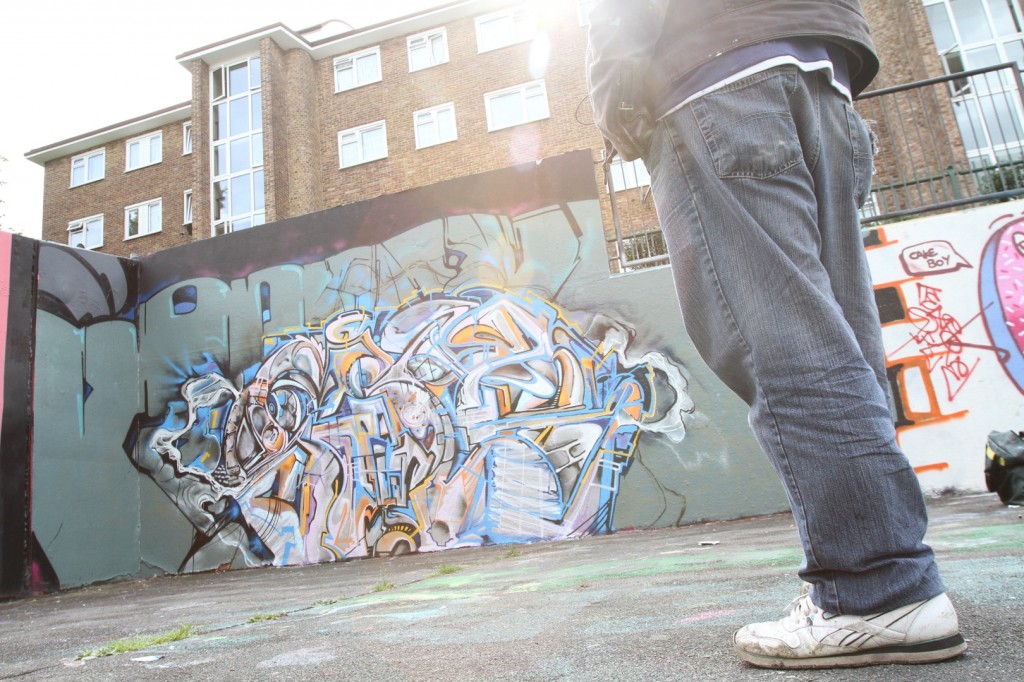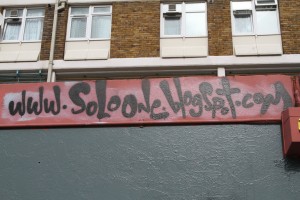
In a basketball court sunk beneath street level, just a few minutes from Brixton tube and hidden in the warren of a housing estate, is one of London’s most internationally famous graffiti galleries. The Hall of Fame off Broomgrove Road, SW9, has become the first stop for professional street artists when they visit the city. And it’s all down to the work of one man, Brixton artist Solo, who founded and maintains the basketball court.
Let’s get one thing over with first – Solo is quick to point out that ‘graffiti art’ and ‘street artists’ are media terms. The people who paint here are called ‘writers’. “It comes from the art of writing letterforms”, he says. “You wouldn’t really want to use ‘graffiti artist’ as your term, because it has a negative connotation. When people use ‘graffiti’ and ‘artist’ it’s almost a contradiction.”
Choose two days in a week to visit the Hall of Fame and each time you’ll see something new. Solo started painting the court when he moved to Brixton, but in the last five years he started improving the standard. “I tried to make it into more of an outdoor gallery with a more professional usage. Yesterday we had guys from Australia. Last year, we had Tats Cru and Goldie who came and shot a film down here. We’ve had Slick from L.A who used to do the Ice Cube videos, we’ve had Ivory from New York, really old school New York legends. Whoever’s here in town will come to drop a piece, because it’s kind of the only remaining basketball court that gets painted in London.”
The work in the Hall of Fame court isn’t just seen by local residents and the artists. It all goes on flickr and blogs, so that more people see it on the internet than in real life. “Your audience here is the residents – the kids come down here, but the older residents rarely venture in. They’ll lean over and ask what you’re painting. It looks slightly strange because you’re constantly replacing all the works, but what happens is that it goes out on the internet, so your audience is out there. You can get 10,000 hits off one piece.”
The motivation for writers like Solo is a far cry from the vandalistic stereotype of the graffiti artist in the mainstream press. “It’s a form of expression. If you don’t do something like this you’re just consuming – a lot of people don’t create anything. They just access the internet, look, but don’t actually participate in making anything from nothing. With the photos, I’ll travel or get jobs in other countries. Recently I did City of Gold in Johannesburg.”
The appeal of the basketball court is clear – the viewer is surrounded by the high walls, each one painted with a different artwork, and in turn surrounded by an urban estate. ”I’ve always like basketball courts. It’s a challenge to do – I don’t need to go to the gym. My style is making the letter forms and then I smash it so it disintegrates. I like to make it look really broken and quite sketchy, not too airbrushed. I do freestyle graffiti – no plan, no sketch, just doing it straight off the top and see where it goes. Some people will plan it out or have stuff pre-cut.” One work usually takes about five or six hours for Solo. The day before we interviewed him in the court, a group of French writers had painted one wall all of them blindfolded and all at once. The results were beautiful.
Solo teaches workshops for children in Southwark , but he says Lambeth council are much less receptive to the creativity it can bring. Indeed, the basketball court itself is currently in danger, with proposals to take one of the high walls down to street level. “If that does happen, I’ll fight it all the way, because this is one of the few remaining basketball courts in London for this to exist. With this gone, then this area loses something that has quite significant input into the area. it should be encouraged, it should be supported, because it brings that positive energy to Brixton and a bit to the economy, do you know what I mean?”
For now, though, the court remains and paintings are being created there almost every day, as long as it’s not raining of course. As we left Solo, he was preparing another wall for a painting to do on the day of Splash and the work pictured here would have disappeared the next day.
You can see Solo’s work at www.soloone.blogspot.com




